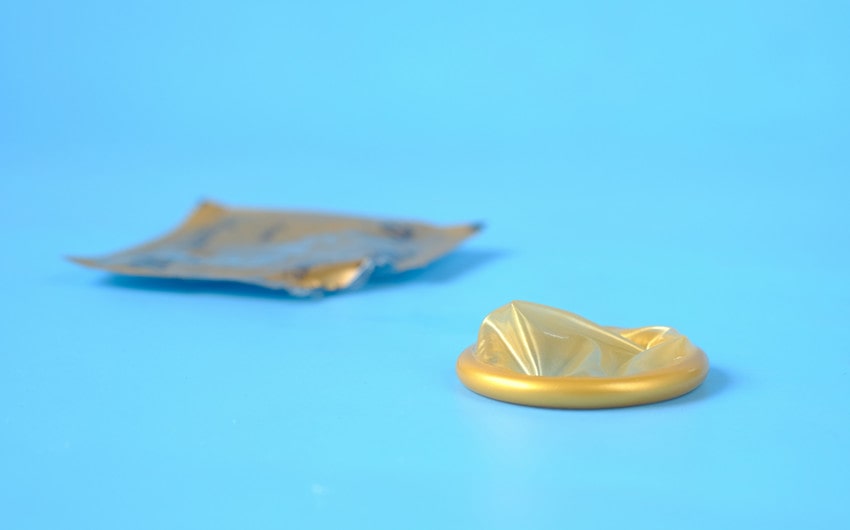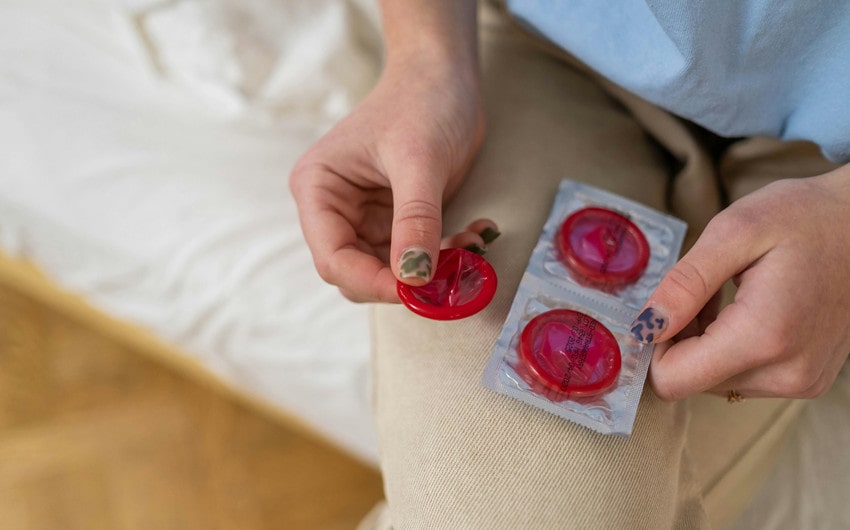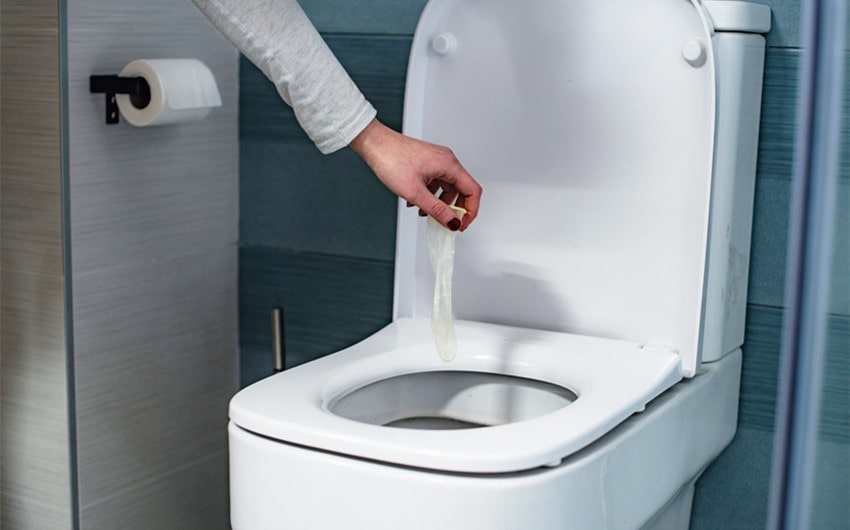Can You Flush Condoms? Here’s Why It’s a Bad Idea
After a moment of passion, it’s easy to wonder about quick cleanup solutions—like tossing a used condom in the toilet. But can you flush condoms without running into trouble? The short answer is no. Flushing condoms can cause serious plumbing clogs and harm the environment.
Toilets are designed for waste and toilet paper, not latex or similar materials that don’t break down easily. Instead, learning the right way to dispose of them ensures you avoid unexpected plumbing issues and do your part to protect the planet. Let’s explore why flushing condoms isn’t a good idea and what you can do instead.
What Happens If You Flush a Condom?

Flushing a condom may seem like a quick way to get rid of it, but it can lead to several problems—both for your plumbing system and the larger sewer infrastructure. Below is a detailed look at what can happen when a condom is flushed.
1. Clogged Pipes and Blocked Drains
Condoms are made from materials like latex or polyurethane, which are designed to be durable and stretchable. These materials don’t dissolve in water, meaning they can easily get stuck in the curves of pipes or narrow drains. Over time, other debris such as toilet paper or waste can accumulate around the condom, creating a blockage. This may lead to slow-draining water or complete clogs, requiring expensive plumbing repairs.
2. Damage to Septic Systems
For homes that rely on septic systems, flushing condoms is a particularly bad idea. Septic tanks are meant to break down organic waste, but materials like condoms don’t decompose. As a result, they can linger in the system, disrupting the natural bacterial process and potentially causing backups or overflows. In severe cases, the entire septic system might need maintenance or repair, which can be costly and time-consuming.
3. Stress on Public Sewer Systems
If the condom makes it through your home’s pipes, it can still cause trouble in public sewer systems. Sewer systems are not designed to handle items that don’t break down, like condoms. These objects can get tangled with other non-flushable items—like wet wipes or sanitary products—forming massive blockages known as “fatbergs.” Fatbergs are hard to remove and often result in sewer overflows, causing environmental contamination and costly repairs for local municipalities.
4. Risk of Toilet Overflow
In some cases, flushing a condom might cause an immediate issue, leading to your toilet backing up and overflowing. If a clog forms right away, you could be faced with a messy and frustrating cleanup. This is especially inconvenient if it happens when you’re hosting guests or during busy moments in daily life.
5. Increased Water Usage for Fixing Issues
If plumbing issues occur, you’ll likely need to flush multiple times or use large amounts of water to attempt to clear the clog. In areas where water conservation is important, this waste of water can have environmental and financial consequences. Calling in a plumber to fix serious clogs may also involve the use of heavy-duty equipment that further adds to water usage.
Environmental Consequences of Flushing Condoms
Flushing condoms may seem harmless, but it can cause significant environmental damage. As these materials enter water systems and sewer networks, they contribute to pollution and create hazards for wildlife. Below are the key environmental consequences of flushing condoms.
1. Non-Biodegradable Materials Harm Waterways
Most condoms are made from latex, polyurethane, or other synthetic materials designed to be durable and resistant to breaking. Unfortunately, these materials do not decompose naturally in water. Once flushed, condoms can end up in rivers, lakes, and oceans through sewer overflows or improper wastewater treatment. Since they persist for years in the environment, they contribute to long-term pollution of our water systems.
2. Threat to Marine Life and Animals
Once condoms enter oceans or rivers, they pose a serious threat to marine creatures. Fish, turtles, and birds may mistake these objects for food, leading to ingestion that can block their digestive systems and cause death. Similarly, animals can get entangled in condoms, restricting their movement or causing injury. This unnecessary harm adds to the growing problem of plastic and synthetic waste affecting aquatic ecosystems worldwide.
3. Blockages in Sewer Systems Lead to Pollution
When condoms clog public sewer systems, it can trigger overflows that release untreated sewage into the environment. These sewer backups introduce harmful bacteria, chemicals, and solid waste into natural water bodies, making them unsafe for both wildlife and human use. Such pollution can also lead to beach closures, contamination of drinking water supplies, and negative impacts on tourism and recreation.
4. Increased Burden on Wastewater Treatment Plants
Although wastewater treatment plants are designed to remove organic waste, they are not equipped to filter out non-biodegradable items like condoms. Flushed condoms often bypass these filtration systems and remain in the sludge or water that is eventually released back into rivers and oceans. This adds to the environmental burden and puts unnecessary strain on the treatment process, requiring more resources and labor to manage the waste.
5. Contribution to Microplastic Pollution
Over time, condoms can degrade into smaller fragments, though they don’t fully decompose. These tiny pieces contribute to the growing issue of microplastic pollution, which is increasingly found in oceans, rivers, and even the food we consume. Microplastics pose health risks to both wildlife and humans, as they can accumulate in the bodies of animals and enter the human food chain through seafood consumption.
6. Impact on Coastal Communities and Tourism
For coastal communities that rely on clean beaches and healthy ecosystems, flushed condoms pose a serious problem. When these items wash ashore, they become an unsightly pollutant that affects the natural beauty of beaches and discourages tourism. Cleaning up non-biodegradable waste requires both time and resources, placing an additional burden on local governments and communities.
7. Worsening the Global Waste Crisis
Every year, tons of non-biodegradable waste end up in landfills, water bodies, and oceans, adding to the global waste crisis. Flushing condoms instead of disposing of them properly exacerbates this issue by contributing to unnecessary waste in water systems. It highlights the importance of reducing single-use items and encouraging proper disposal practices to minimize our impact on the environment.
The Best Way to Dispose of Condoms

Proper condom disposal is essential to protect both your plumbing and the environment. While flushing them down the toilet might seem like a quick solution, it can lead to clogs, sewer issues, and environmental harm. Below are the best ways to dispose of condoms responsibly.
1. Throwing Condoms in the Trash
The safest and easiest way to dispose of a condom is to wrap it up and throw it in the trash. Follow these steps for proper disposal:
- Tie the condom: After use, tie the condom in a knot to prevent any leakage of fluids.
- Wrap it up: Use tissue paper or toilet paper to wrap the condom. This helps contain it and avoids mess in the trash can.
- Place it in the garbage bin: Dispose of the wrapped condom in a regular trash bin. Using a small bag within your bathroom bin can help contain odors.
This simple routine ensures the condom stays out of plumbing systems and the environment.
2. Using Biodegradable Trash Bags
If you are concerned about minimizing waste, consider placing used condoms in biodegradable trash bags. Although condoms themselves are not biodegradable, using eco-friendly bags for disposal can reduce your environmental impact. Once the bag is full, seal it and place it in the regular garbage bin.
3. Avoiding Public Toilet Disposal
If you are away from home, it’s essential to resist the temptation to flush a condom in a public restroom. Toilets in restaurants, hotels, or public places often have plumbing systems that are more prone to clogs. Keep a small bag or tissue with you to wrap the condom, and dispose of it in the restroom’s trash bin or take it with you until you find a proper bin.
4. Do Not Flush Any Condom Types
Some people believe that certain condoms, such as thinner or non-latex options, may be flushable. However, no condom type should be flushed. Even condoms marketed as “natural” or “eco-friendly” do not break down in water and can still cause clogs and environmental harm.
5. Consider Using Condom Disposal Bags
Specialized disposal bags designed for sanitary items, such as those used for diapers or menstrual products, are another option. These small, sealable bags trap odors and keep used condoms discreet. They can then be safely thrown away in the trash without making a mess.
6. Keep Disposal Discreet and Hygienic
If privacy is a concern, such as in shared living spaces or when guests are around, follow these tips for discreet disposal:
- Double-wrap the condom in paper or a small plastic bag to prevent odors.
- Use a bathroom trash bin with a lid to keep waste contained and out of sight.
- Empty the trash regularly to avoid any lingering odors or awkward situations.
7. Using Eco-Friendly Alternatives
While most condoms are not biodegradable, there are some emerging alternatives made from natural materials. For example, lambskin condoms are known to decompose more easily compared to synthetic ones, though they don’t offer protection against sexually transmitted infections (STIs). If environmental impact is a priority, explore these alternatives while still disposing of them in the trash.
What to Do If You Accidentally Flushed a Condom
Accidentally flushing a condom can cause panic, but quick action can help minimize damage to your plumbing or septic system. Here are the steps you should take if you find yourself in this situation.
1. Don’t Flush Again
If you realize that the condom has been flushed, avoid flushing the toilet again in an attempt to push it down further. Additional flushing can cause the condom to move deeper into the pipes, making it harder to retrieve and increasing the risk of a blockage.
2. Check for Immediate Signs of Blockage
Observe if the toilet is draining slower than usual or if water is rising when you flush. If the water backs up or the toilet bowl fills unusually high, it’s a clear sign that the condom might be causing a blockage. Addressing this right away can prevent a more serious plumbing issue.
3. Use a Plunger
If you notice signs of blockage, try using a plunger to dislodge the condom. Here’s how to do it properly:
- Ensure the toilet bowl has enough water to create a seal with the plunger.
- Place the plunger over the drain hole and push down firmly, then pull back up repeatedly.
- Try several cycles of plunging to see if the blockage clears.
This method works best if the condom hasn’t moved too far down the pipes yet.
4. Try a Toilet Auger (Plumbing Snake)
If plunging doesn’t resolve the issue, a toilet auger (or plumbing snake) may help. This tool is designed to reach deeper into the pipes to break up or pull out obstructions. Follow these steps:
- Insert the auger into the toilet drain and rotate the handle to extend the coil.
- Once you feel resistance (possibly the condom), continue turning to hook or dislodge it.
- Pull the auger back slowly and see if the water starts draining properly.
If you successfully remove the blockage, be sure to disinfect the auger afterward.
5. Use Hot Water and Dish Soap
For minor blockages, pouring hot water mixed with a small amount of dish soap into the toilet can help. The heat can soften the condom slightly, while the soap reduces friction, allowing it to slide further down or disintegrate part of the blockage. However, this method is less effective if the condom has traveled deep into the pipes.
6. Monitor Your Plumbing
Even if the toilet appears to be functioning normally, it’s a good idea to monitor it for the next few days. A flushed condom may still be lodged in the pipes, causing intermittent clogs or slow drainage. Pay attention to any strange noises, slow-flushing toilets, or water backing up in other drains.
7. Call a Plumber if Needed
If plunging, snaking, or using hot water doesn’t work, it’s time to contact a plumber. Professional plumbers have specialized tools, such as hydro jets, to remove deep blockages without damaging your pipes. Waiting too long can lead to more severe clogs and even pipe bursts, so it’s better to seek help sooner rather than later.
8. Prevent Future Incidents
After resolving the issue, take steps to avoid flushing non-flushable items in the future. Consider keeping a small trash bin next to the toilet for convenient disposal of condoms and other bathroom waste. Educating everyone in your household about what can and cannot be flushed will also prevent future plumbing problems.
9. Septic System Owners: Check for Further Issues
If your home relies on a septic system, be cautious. Even if the immediate problem seems resolved, the condom may have traveled into the septic tank, where it could interfere with normal operation. In such cases, having your septic system inspected by a professional is a smart move to avoid long-term complications.







